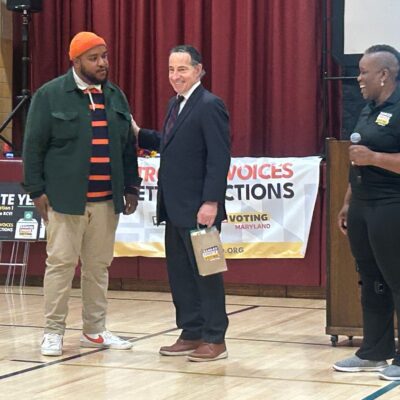 by Kristen Weaver, Mayor Pro Tem of Greenbelt City Council
by Kristen Weaver, Mayor Pro Tem of Greenbelt City Council
The fundamental question of how we choose our elected representatives is very important, and there are pros and cons to all voting systems. In comparing our current system to multi-winner, proportional ranked choice voting for the upcoming referendum, the 40% and 12.5% thresholds are comparing two different things, something which I’m hoping I can help clarify. In addition, while I understand the fear of extremism, that doesn’t match the experience of other communities that already use ranked choice voting, where councils tend to become more representative of the community, and geographic representation can emerge organically. Finally, ranked choice voting can increase voter turnout, which currently is desperately low in Greenbelt’s municipal elections.
The 12.5% Threshold Versus the 40% Threshold
In our current system, 40% of voters need to cast one of their multiple votes for a particular candidate for them to be eligible to win. With ranked choice voting (RCV), you are only considering each voter’s top choice at any given time, starting with the candidate they ranked first, while our current 40% threshold looks at all seven votes all at once.
In the ice cream sample ballot from over Labor Day Weekend, Mint Chocolate Chip got 17.2% of the first-choice votes. This does not mean only 17.2% of voters voted for Mint Chocolate Chip. An additional 12.5% of voters voted for it second, 10.9% third and so on, for a total of 64.1% of voters ranking Mint Chocolate Chip on their ballots at some level of preference. Because the threshold is 12.5%, Mint Chocolate Chip would be elected in the Round 1 with 17.2% of first-choice votes but 64.1% support overall (the latter analogous to our current system results.) For comparison, Rocky Road, the seventh and last flavor selected, only got 7.8% of first choice votes, under the 12.5% RCV threshold. However, 60.9% of voters ranked it somewhere on the ballot, and it passed the RCV threshold in Round 9. The 12.5% threshold and the 40% threshold serve different purposes and should be considered within the system they operate, not compared to each other.
Improved Representation in Other Communities
I recognize the fear of extreme voices being elected, as raised in the Greenbelt News Review editorial. However, that doesn’t match the experience of communities who have been using this method of voting for a long time. Instead, they have found that RCV makes the council more representative of the community. For example, Cambridge, Massachusetts has been using RCV for more than 80(!) years, since 1941. They elect their nine-member, all at-large council every two years, so a substantially similar situation to Greenbelt. As a benefit of RCV, their election website specifically states, “more diverse candidates win elections. Cities that have implemented ranked choice voting have elected more women and more women of color, making their elected officials more representative of their communities.” The Fair Vote article on Cambridge elections describes how neighborhood representation can arise naturally, as in the graphic from the 2017 election and their accompanying description:
In the example below, the 9 members elected to Cambridge’s city council in 2017 each earned support from different precincts, with many of the winners demonstrating a clear ‘neighborhood’ of support, while others had more crossover support in different portions of the city. Proportional RCV allows voters to form coalitions across a variety of issues or geographies, and ensure representation regardless of which issues bring together that bloc of voters. (All 9 councilors are chosen at-large, and the black line simply shows that the northern half of the city is less densley [sic] populated than the southern half).
Representation of women and people of color also increased, as Fair Vote notes, “Since 1980, when Cambridge’s Black population crossed 10% of the town’s total voting age population, Black members have always had representation on both bodies, sometimes even with two representatives on a body.” Greenbelt has a very diverse population but has only ever had White or Black members of council (and the latter only since 2009), never a Latino or Asian American councilmember, despite substantial populations of those ethnicities in the city. The Cambridge City Council also has a larger percentage of female council members than similar nearby cities. I’d also like to point out that in the 2021 elections in Cambridge, which have a nice visual results summary available, they had 19 named candidates, only one of which reached their even lower threshold of 10% in the first round. The next candidate was elected in round 7, after multiple candidates from the bottom of the list were eliminated, showing the wide distribution of support for other candidates.
I spoke personally with a councilmember from Albany, California, and emailed with several others. They are a community of 20,000 people within a footprint of only 1.8 square miles, and elect a five-member council to staggered four-year terms. They have used RCV since 2022, so in only two election cycles thus far. However, even in that first election, they had a Latino/Indigenous member of council elected for the first time, and also elected an Asian American for the first time in 18 years, with all White councils in between. From the U.S. Census Bureau’s Citizen Voting Age Population estimates, one-fourth of potential voters in Albany are Asian American and one-eighth Latino. Their council now looks substantially more like their community than it did before RCV.
As a side note, the staggered four-year terms while maintaining all at-large seats and also using RCV is certainly a possibility for Greenbelt, if we choose to go that way. That could look like electing four seats one election year, and three seats the next two-year cycle, which gains the benefits of RCV while maintaining our all at-large system, but would increase the threshold for election to 20% and 25% respectively which might alleviate some concerns. The staggered terms prevent the possibility of most (or all) of council turning over at the same time, something that hasn’t happened in recent history in Greenbelt, but has happened in other communities, and can be a significant disruption if everyone is new at the same time.
Voter Engagement and Turnout
All of this is a lot to take in and a lot to consider, but I would like to end with a final point about voter engagement. Proportional ranked choice voting has been shown to increase voter turnout, something I would very much like to see improve in Greenbelt. RCV results in a larger share of voters electing a representative they strongly support, so word spreads that it is more worthwhile to vote. George Pillsbury from the Center for Voting and Democracy did an analysis of voter turnout in Cambridge compared to nearby cities without RCV from the 1960’s through the early 1990’s. While there was a decline in voter turnout in all cities during that period, Cambridge showed the least decline, and “Cambridge ended the study about 10 percentage points above the other 3 cities despite the fact that all other 3 cities had strong mayors compared to Cambridge’s Plan E city manager form of government and that turnout is ordinarily higher in municipal elections with mayoral contests.” Another example of increased turnout comes from an analysis of voting in Swiss communities, which found that participation in the communities using proportional representation averaged 72% compared to only 53% in the communities using a majority system. I dearly wish for even those lower participation numbers in Greenbelt elections, but regardless, the difference is significant.
 In conclusion, I know change is hard, and sometimes scary, but I hope everyone will consider all the factors that play into ranked choice voting and how it can benefit Greenbelt overall, and vote yes on Advisory Referendum One. Substantial community engagement would take place before the final details are put in place for a charter amendment changing our voting process, but the first step is affirming that we want to try a new way of thinking about Greenbelt elections.
In conclusion, I know change is hard, and sometimes scary, but I hope everyone will consider all the factors that play into ranked choice voting and how it can benefit Greenbelt overall, and vote yes on Advisory Referendum One. Substantial community engagement would take place before the final details are put in place for a charter amendment changing our voting process, but the first step is affirming that we want to try a new way of thinking about Greenbelt elections.
More resources to look at, including those linked in the article above:
- Multiple winner elections explained by Minnesota Public Radio using sticky notes (video)
- Explanation of RCV from Fair Vote (video)
- Explanation of Greenbelt Ice Cream election from Labor Day (video)
- Albany, California 2022 election results visualized
- Cambridge, Massachusetts 2021 election results visualized
- Fair Vote article about Cambridge
- Analysis of voter turnout in Cambridge versus nearby cities
- Analysis of voter turnout in Swiss communities
Kristen Weaver is Mayor Pro Tem of the Greenbelt City Council.












Maria Silvia Miller
Great Posts Susan! Ranked Choice Voting is very confusing for most. I am glad you posted Kristen Weaver’s article.
Fair Winds,
Maria Silvia Miller